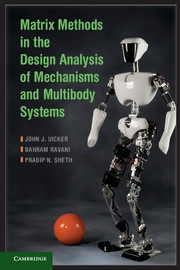Book contents
- Frontmatter
- Contents
- Preface
- About the Authors
- 1 Concepts and Definitions
- 2 Topology and Kinematic Architecture
- 3 Transformation Matrices in Kinematics
- 4 Modeling Mechanisms and Multibody Systems with Transformation Matrices
- 5 Posture Analysis by Kinematic Equations
- 6 Differential Kinematics and Numeric Solution of Posture Equations
- 7 Velocity Analysis
- 8 Acceleration Analysis
- 9 Modeling Dynamic Aspects of Mechanisms and Multibody Systems
- 10 Dynamic Equations of Motion
- 11 Linearized Equations of Motion
- 12 Equilibrium Posture Analysis
- 13 Frequency Response of Mechanisms and Multibody Systems
- 14 Time Response of Mechanisms and Multibody Systems
- 15 Collision Detection
- 16 Impact Analysis
- 17 Constraint Force Analysis
- Index
- References
15 - Collision Detection
Published online by Cambridge University Press: 05 April 2013
- Frontmatter
- Contents
- Preface
- About the Authors
- 1 Concepts and Definitions
- 2 Topology and Kinematic Architecture
- 3 Transformation Matrices in Kinematics
- 4 Modeling Mechanisms and Multibody Systems with Transformation Matrices
- 5 Posture Analysis by Kinematic Equations
- 6 Differential Kinematics and Numeric Solution of Posture Equations
- 7 Velocity Analysis
- 8 Acceleration Analysis
- 9 Modeling Dynamic Aspects of Mechanisms and Multibody Systems
- 10 Dynamic Equations of Motion
- 11 Linearized Equations of Motion
- 12 Equilibrium Posture Analysis
- 13 Frequency Response of Mechanisms and Multibody Systems
- 14 Time Response of Mechanisms and Multibody Systems
- 15 Collision Detection
- 16 Impact Analysis
- 17 Constraint Force Analysis
- Index
- References
Summary
Introduction
Through simulation of multibody systems as explained in the preceeding chapters, we can solve a variety of useful problems with no further enhancement. However, with the methods explained so far, we still lack the capability to simulate collisions, either between moving bodies or between a single moving body and its fixed surroundings. Simulation software developed strictly with the formulae presented so far assumes that a moving body may simply pass through others with no interference or impact. Clearly, this can benefit from enhancement.
Collision or contact between bodies cannot be detected unless it is through computations relating the geometries of the bodies’ surfaces. Therefore, we must have accurate geometric shapes for all bodies for which collisions are to be considered, and in as much detail and accuracy as we wish to monitor their possible contact. We need data for vertices, edges, and surfaces, and we need to distinguish the material from the exterior sides of such surfaces. Therefore, we need solid models of the bodies to be considered. Either constructive solid geometry (CSG) or boundary representation (B-Rep) or hybrid combinations may be considered, but wire-frame data are not sufficient.
Information
- Type
- Chapter
- Information
- Publisher: Cambridge University PressPrint publication year: 2013
